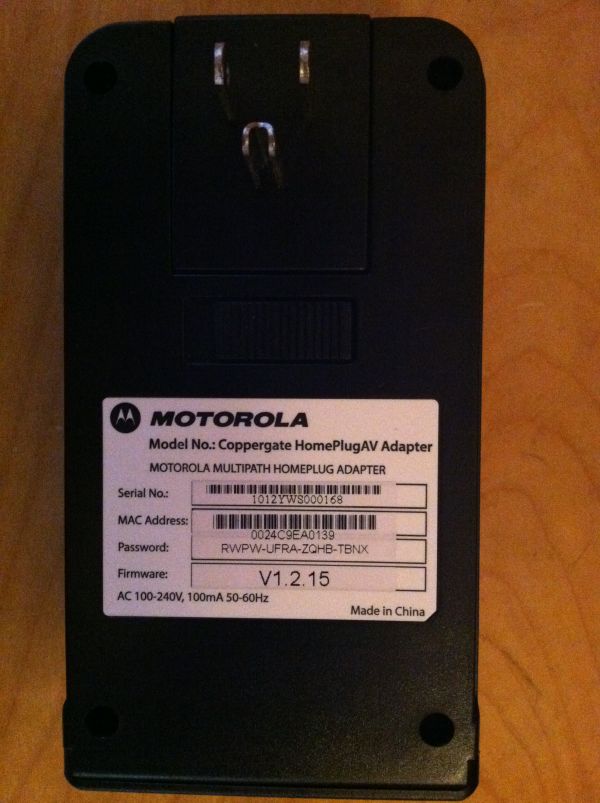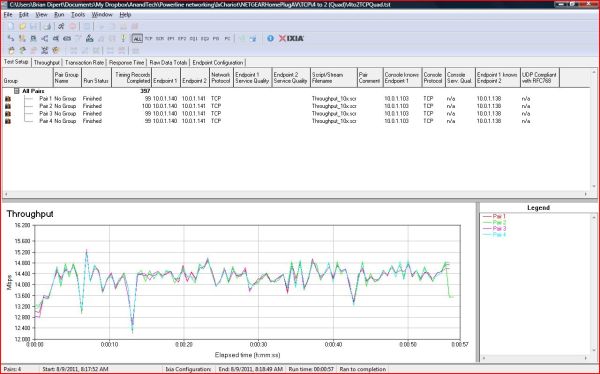Hands-On Powerline Networking: How Well (Or Not) Are Latest-Generation Devices Working?
by Brian Dipert on September 1, 2011 12:41 AM EST- Posted in
- Networking
- Powerline Adapters
- NetGear
Speaking of adapters, which ones received scrutiny in this study? The five 'base case' adapters were Netgear's XAV2001 HomePlug AV 200 units, which I made sure beforehand were upgraded to the latest-available v0.2.0.5NA firmware release, and are based on the Qualcomm third-generation INT6400 chipset:
Sigma Designs' CG2110 chipset was the foundation of the Motorola-branded (and Sigma Designs-supplied) second HomePlug AV adapter suite that I tested. These particular units offer three-prong power plugs, thereby at least conceptually implementing Sigma Designs' earlier-mentioned ClearPath technology for optionally routing powerline networking traffic over the earth ground connection:
Note that in this particular case, I was unfortunately only able to obtain three adapters from Sigma Designs, two of which I had connected to the powerline network nodes under test at any particular time, and the third mated to the router. The reason for mentioning this discrepancy will become clear in the next section of this article.
And at the performance high end, at least on paper, are Netgear's five XAV5001 IEEE 1901 adapters, derived from Qualcomm's latest-generation AR7400 chipset. As with the XAV2001s, I made sure that they were updated to the latest-available public firmware (v0.2.0.9NA in this particular case) before subjecting them to my barrage of tests:
Although at any particular point in time I was only measuring bandwidth between any two adapters, I had all of the adapters of any particular technology (five each for Netgear HomePlug AV and IEEE 1901, three for Sigma Designs/Motorola HomePlug AV) connected to the power grid at all times. As with my earlier description of static-vs-DHCP IP address assignments, this decision might not have enabled any particular adapter to operate at highest possible performance, because it was periodically (albeit briefly) interacting with all of its peers on the premises' power grid. However, such a setup more accurately mimics the way that powerline adapters will be operating in real-life usage settings, which is why I went this route (poor networking pun intended).
I harnessed the Ixia-supplied 'Throughput.scr' script, albeit customizing it to extend the test time by increasing the test-data payload size from 100 KBytes to 1 MByte. And, having learned through past testing situations that powerline adapters (and, more generally, all types of networking equipment) sometimes deliver higher aggregate throughput when more than one stream's worth of data is simultaneously flowing through them, I ran both one- and four-stream testing scenarios:














53 Comments
View All Comments
Arbie - Thursday, September 1, 2011 - link
Yes, it is hard to read. I wasn't going to comment on that until I saw your remark. The style is verbose, with too many words behind every thought, whether or not it's important. "Burrowing through dirty, spider- and snake-infested crawlspaces"? C'mon, that sounds like a 7th grade composition. You've got a good subject and all the smarts; don't mess it up.kmmatney - Thursday, September 1, 2011 - link
I have a Western Digital Powerline that plugs into the router in my basement, with the other outlet at my TV on the second floor. It works great for streaming video, and it also has 4 ports, so I've hooked up my DirectTV box, BlueRay player, and WD live player, and I still have a spare port for a new internet-enabled TV. Overall, a very good solution for $89 or so.bdipert - Thursday, September 1, 2011 - link
Quick aside, speaking of WD Livewire...the company's Outlet has a refurb two-adapter kit for $59.99 right now...http://dealnews.com/Refurb-Western-Digital-Livewir...jabber - Thursday, September 1, 2011 - link
They work well enough in my opinion. As mentioned I only use these as a last resort after physical location/wireless etc. options have failed.abkfenris - Thursday, September 1, 2011 - link
... is the house.crimson117 - Thursday, September 1, 2011 - link
TIL that Anandtech editors' houses are as unique as the editors :)Great article!
edved - Thursday, September 1, 2011 - link
I've been using the AV 307's for about 3-4 months now and they're great. I'm streaming huge data, HD video and uncompressed audio without a hiccup. Literally plug and play, this is the best way to go! I've now got my Panny Tv, Blu ray player, WDLive, Onkyo 509 all piped-in thanks to the 307's!Can't recommend it enough.
my2cents.
casteve - Thursday, September 1, 2011 - link
These $50 powerline adapters are just one LAN connection away from expensive electronics. Since you can't connect them directly to a surge protector, what internal protection do they have for the LAN?edved - Thursday, September 1, 2011 - link
I paid over $100 for mine, but wasn't ready to start "Burrowing through dirty, spider- and snake-infested crawlspaces"!bobbozzo - Thursday, September 1, 2011 - link
I had some Logitech security cameras last year, which came with separate powerline adapters; they claimed to have built-in surge suppressors, but no KV or other ratings were specified.I put them on some APC surge suppressors, and they worked for several days and then lost the connection, so I had to move them off the APCs.